adding oil FORD SUPER DUTY 2014 3.G Diesel Supplement Manual
[x] Cancel search | Manufacturer: FORD, Model Year: 2014, Model line: SUPER DUTY, Model: FORD SUPER DUTY 2014 3.GPages: 82, PDF Size: 3.12 MB
Page 45 of 82
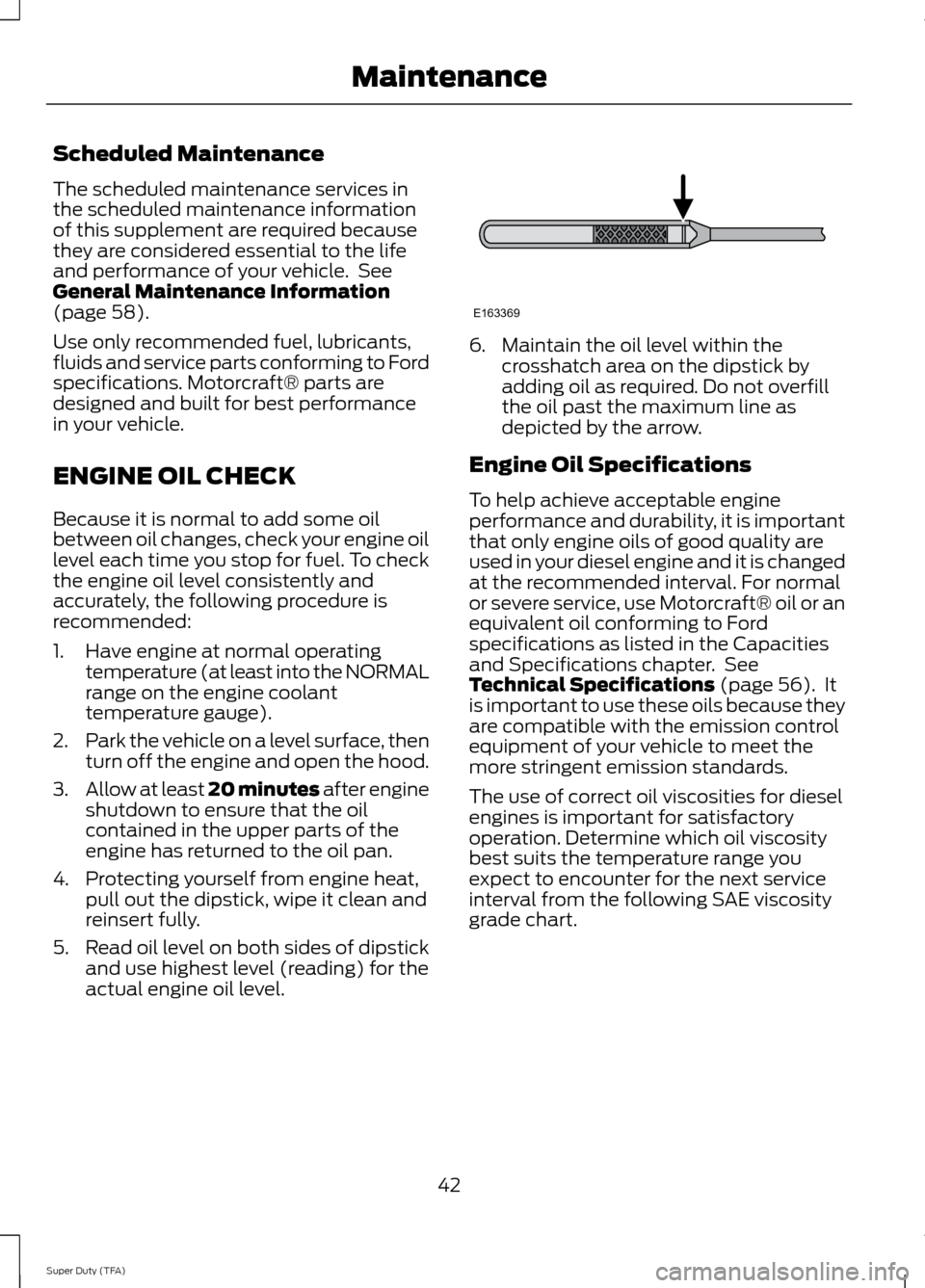
Scheduled Maintenance
The scheduled maintenance services in
the scheduled maintenance information
of this supplement are required because
they are considered essential to the life
and performance of your vehicle. See
General Maintenance Information
(page 58).
Use only recommended fuel, lubricants,
fluids and service parts conforming to Ford
specifications. Motorcraft® parts are
designed and built for best performance
in your vehicle.
ENGINE OIL CHECK
Because it is normal to add some oil
between oil changes, check your engine oil
level each time you stop for fuel. To check
the engine oil level consistently and
accurately, the following procedure is
recommended:
1. Have engine at normal operating temperature (at least into the NORMAL
range on the engine coolant
temperature gauge).
2. Park the vehicle on a level surface, then
turn off the engine and open the hood.
3. Allow at least 20 minutes after engine
shutdown to ensure that the oil
contained in the upper parts of the
engine has returned to the oil pan.
4. Protecting yourself from engine heat, pull out the dipstick, wipe it clean and
reinsert fully.
5. Read oil level on both sides of dipstick
and use highest level (reading) for the
actual engine oil level. 6. Maintain the oil level within the
crosshatch area on the dipstick by
adding oil as required. Do not overfill
the oil past the maximum line as
depicted by the arrow.
Engine Oil Specifications
To help achieve acceptable engine
performance and durability, it is important
that only engine oils of good quality are
used in your diesel engine and it is changed
at the recommended interval. For normal
or severe service, use Motorcraft® oil or an
equivalent oil conforming to Ford
specifications as listed in the Capacities
and Specifications chapter. See
Technical Specifications
(page 56). It
is important to use these oils because they
are compatible with the emission control
equipment of your vehicle to meet the
more stringent emission standards.
The use of correct oil viscosities for diesel
engines is important for satisfactory
operation. Determine which oil viscosity
best suits the temperature range you
expect to encounter for the next service
interval from the following SAE viscosity
grade chart.
42
Super Duty (TFA) MaintenanceE163369
Page 47 of 82
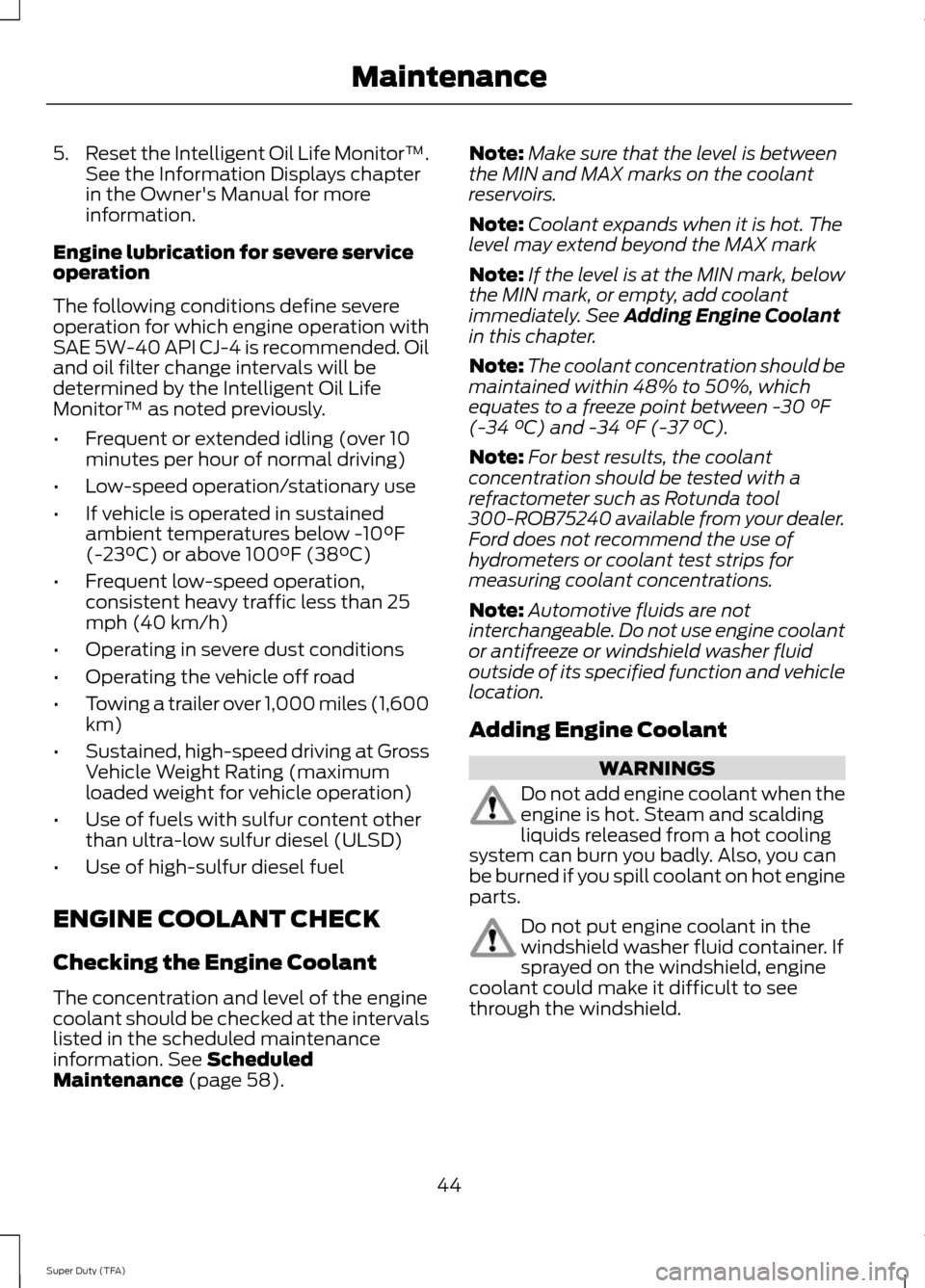
5.
Reset the Intelligent Oil Life Monitor™.
See the Information Displays chapter
in the Owner's Manual for more
information.
Engine lubrication for severe service
operation
The following conditions define severe
operation for which engine operation with
SAE 5W-40 API CJ-4 is recommended. Oil
and oil filter change intervals will be
determined by the Intelligent Oil Life
Monitor™ as noted previously.
• Frequent or extended idling (over 10
minutes per hour of normal driving)
• Low-speed operation/stationary use
• If vehicle is operated in sustained
ambient temperatures below -10°F
(-23°C) or above 100°F (38°C)
• Frequent low-speed operation,
consistent heavy traffic less than 25
mph (40 km/h)
• Operating in severe dust conditions
• Operating the vehicle off road
• Towing a trailer over 1,000 miles (1,600
km)
• Sustained, high-speed driving at Gross
Vehicle Weight Rating (maximum
loaded weight for vehicle operation)
• Use of fuels with sulfur content other
than ultra-low sulfur diesel (ULSD)
• Use of high-sulfur diesel fuel
ENGINE COOLANT CHECK
Checking the Engine Coolant
The concentration and level of the engine
coolant should be checked at the intervals
listed in the scheduled maintenance
information. See Scheduled
Maintenance (page 58). Note:
Make sure that the level is between
the MIN and MAX marks on the coolant
reservoirs.
Note: Coolant expands when it is hot. The
level may extend beyond the MAX mark
Note: If the level is at the MIN mark, below
the MIN mark, or empty, add coolant
immediately. See
Adding Engine Coolant
in this chapter.
Note: The coolant concentration should be
maintained within 48% to 50%, which
equates to a freeze point between -30 °F
(-34 °C) and -34 °F (-37 °C).
Note: For best results, the coolant
concentration should be tested with a
refractometer such as Rotunda tool
300-ROB75240 available from your dealer.
Ford does not recommend the use of
hydrometers or coolant test strips for
measuring coolant concentrations.
Note: Automotive fluids are not
interchangeable. Do not use engine coolant
or antifreeze or windshield washer fluid
outside of its specified function and vehicle
location.
Adding Engine Coolant WARNINGS
Do not add engine coolant when the
engine is hot. Steam and scalding
liquids released from a hot cooling
system can burn you badly. Also, you can
be burned if you spill coolant on hot engine
parts. Do not put engine coolant in the
windshield washer fluid container. If
sprayed on the windshield, engine
coolant could make it difficult to see
through the windshield.
44
Super Duty (TFA) Maintenance
Page 67 of 82
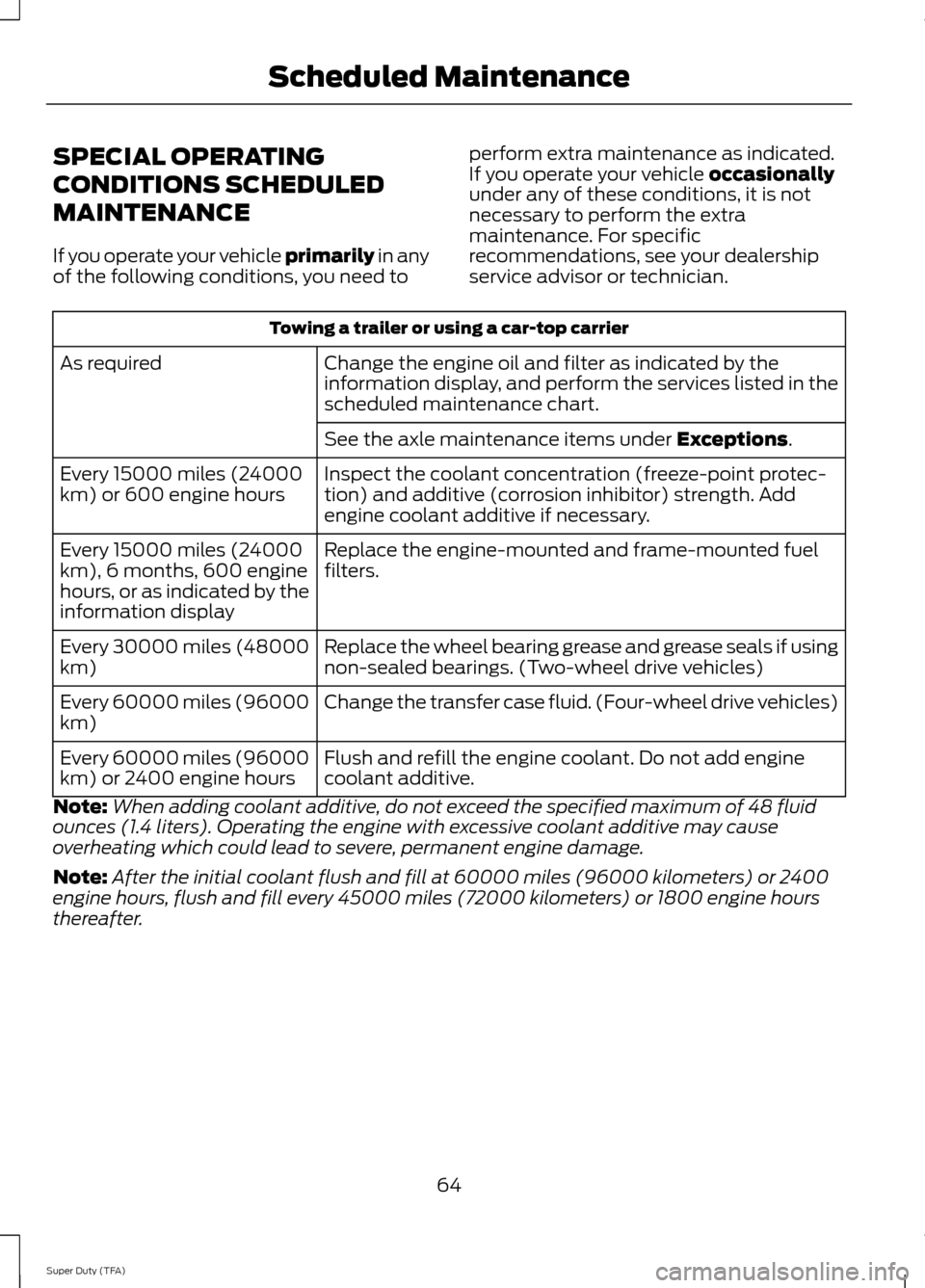
SPECIAL OPERATING
CONDITIONS SCHEDULED
MAINTENANCE
If you operate your vehicle primarily in any
of the following conditions, you need to perform extra maintenance as indicated.
If you operate your vehicle
occasionally
under any of these conditions, it is not
necessary to perform the extra
maintenance. For specific
recommendations, see your dealership
service advisor or technician. Towing a trailer or using a car-top carrier
Change the engine oil and filter as indicated by the
information display, and perform the services listed in the
scheduled maintenance chart.
As required
See the axle maintenance items under
Exceptions.
Inspect the coolant concentration (freeze-point protec-
tion) and additive (corrosion inhibitor) strength. Add
engine coolant additive if necessary.
Every 15000 miles (24000
km) or 600 engine hours
Replace the engine-mounted and frame-mounted fuel
filters.
Every 15000 miles (24000
km), 6 months, 600 engine
hours, or as indicated by the
information display
Replace the wheel bearing grease and grease seals if using
non-sealed bearings. (Two-wheel drive vehicles)
Every 30000 miles (48000
km)
Change the transfer case fluid. (Four-wheel drive vehicles)
Every 60000 miles (96000
km)
Flush and refill the engine coolant. Do not add engine
coolant additive.
Every 60000 miles (96000
km) or 2400 engine hours
Note: When adding coolant additive, do not exceed the specified maximum of 48 fluid
ounces (1.4 liters). Operating the engine with excessive coolant additive may cause
overheating which could lead to severe, permanent engine damage.
Note: After the initial coolant flush and fill at 60000 miles (96000 kilometers) or 2400
engine hours, flush and fill every 45000 miles (72000 kilometers) or 1800 engine hours
thereafter.
64
Super Duty (TFA) Scheduled Maintenance
Page 68 of 82
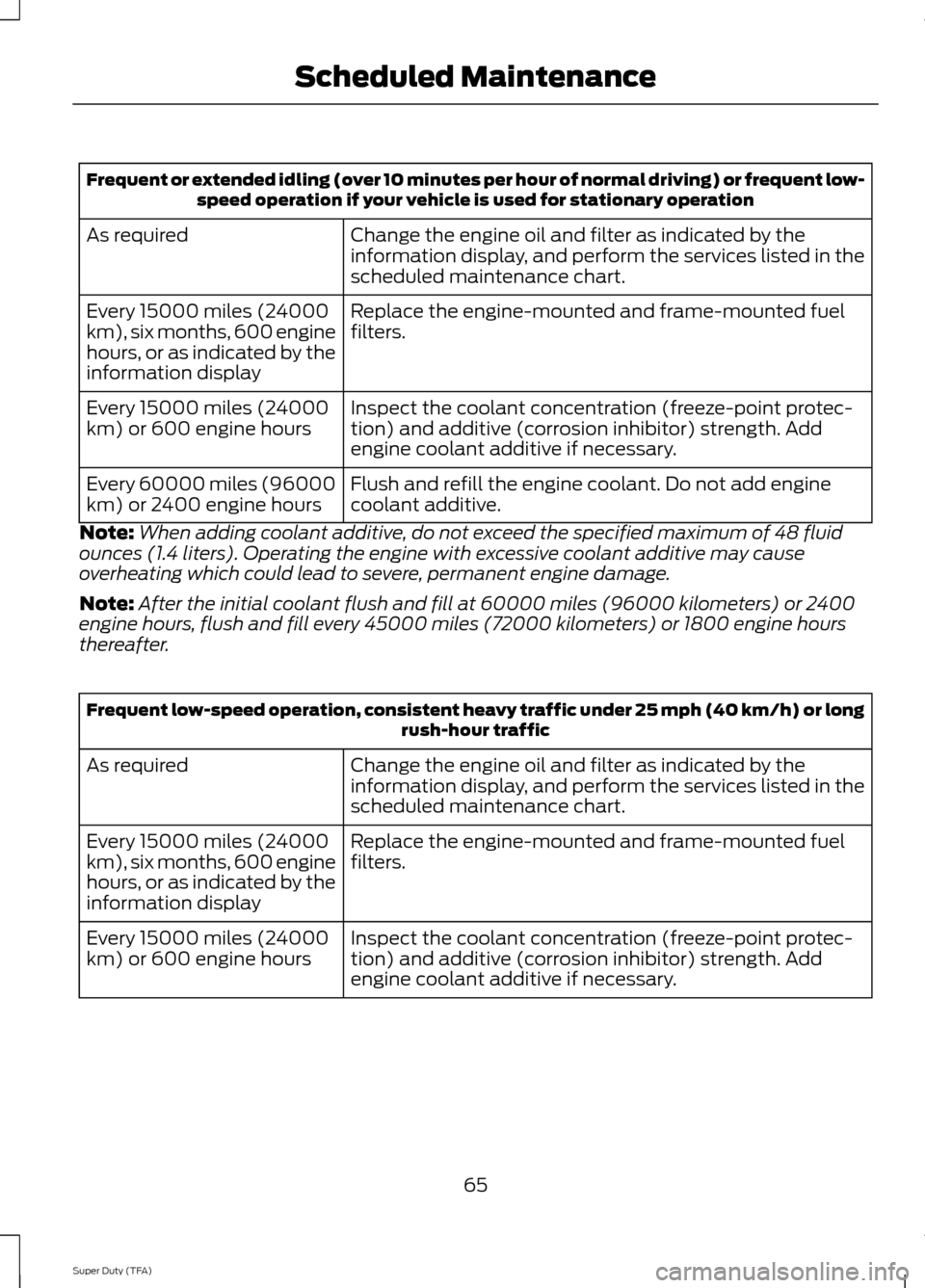
Frequent or extended idling (over 10 minutes per hour of normal driving) or frequent low-
speed operation if your vehicle is used for stationary operation
Change the engine oil and filter as indicated by the
information display, and perform the services listed in the
scheduled maintenance chart.
As required
Replace the engine-mounted and frame-mounted fuel
filters.
Every 15000 miles (24000
km), six months, 600 engine
hours, or as indicated by the
information display
Inspect the coolant concentration (freeze-point protec-
tion) and additive (corrosion inhibitor) strength. Add
engine coolant additive if necessary.
Every 15000 miles (24000
km) or 600 engine hours
Flush and refill the engine coolant. Do not add engine
coolant additive.
Every 60000 miles (96000
km) or 2400 engine hours
Note: When adding coolant additive, do not exceed the specified maximum of 48 fluid
ounces (1.4 liters). Operating the engine with excessive coolant additive may cause
overheating which could lead to severe, permanent engine damage.
Note: After the initial coolant flush and fill at 60000 miles (96000 kilometers) or 2400
engine hours, flush and fill every 45000 miles (72000 kilometers) or 1800 engine hours
thereafter. Frequent low-speed operation, consistent heavy traffic under 25 mph (40 km/h) or long
rush-hour traffic
Change the engine oil and filter as indicated by the
information display, and perform the services listed in the
scheduled maintenance chart.
As required
Replace the engine-mounted and frame-mounted fuel
filters.
Every 15000 miles (24000
km), six months, 600 engine
hours, or as indicated by the
information display
Inspect the coolant concentration (freeze-point protec-
tion) and additive (corrosion inhibitor) strength. Add
engine coolant additive if necessary.
Every 15000 miles (24000
km) or 600 engine hours
65
Super Duty (TFA) Scheduled Maintenance
Page 69 of 82
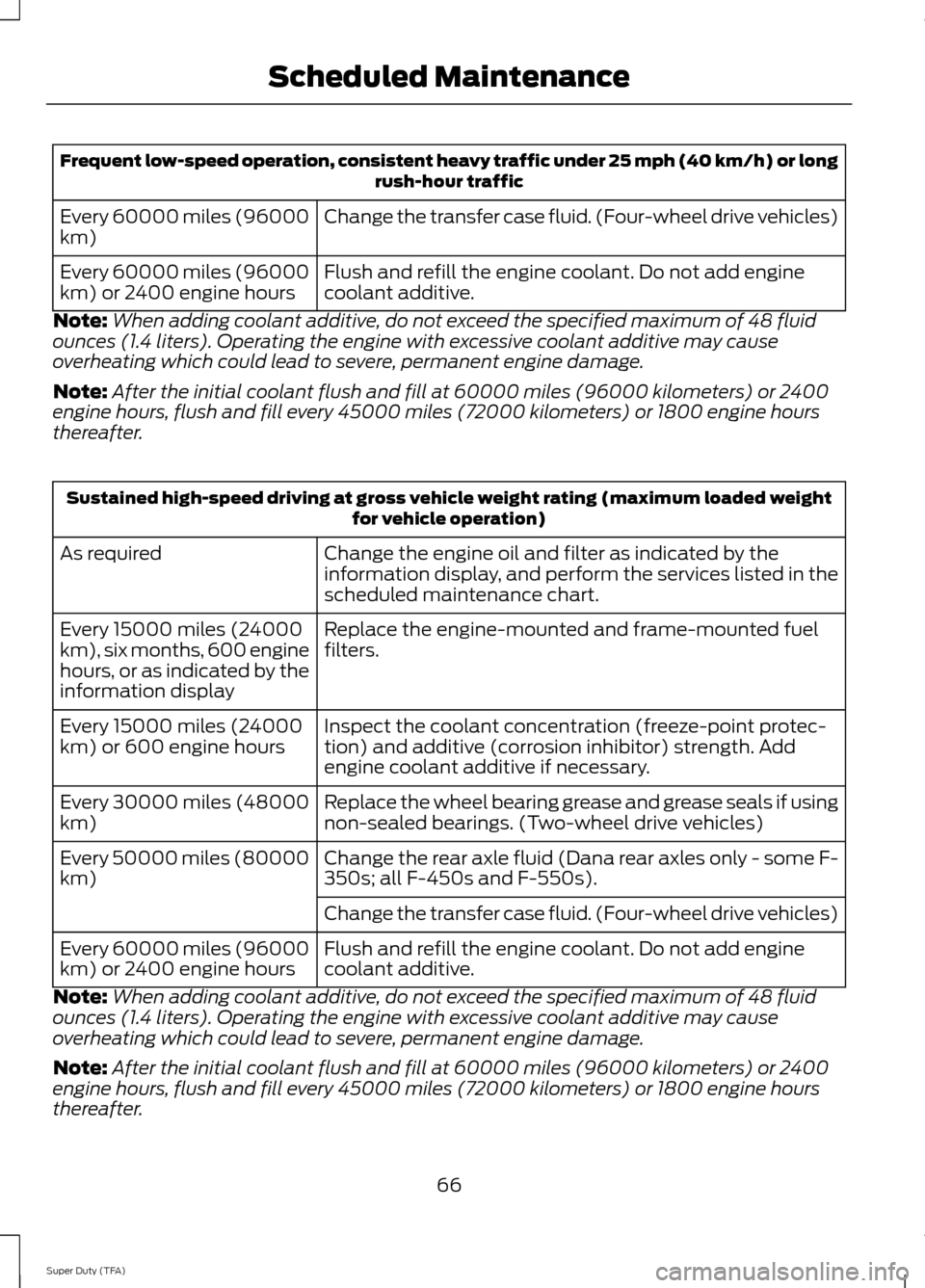
Frequent low-speed operation, consistent heavy traffic under 25 mph (40 km/h) or long
rush-hour traffic
Change the transfer case fluid. (Four-wheel drive vehicles)
Every 60000 miles (96000
km)
Flush and refill the engine coolant. Do not add engine
coolant additive.
Every 60000 miles (96000
km) or 2400 engine hours
Note: When adding coolant additive, do not exceed the specified maximum of 48 fluid
ounces (1.4 liters). Operating the engine with excessive coolant additive may cause
overheating which could lead to severe, permanent engine damage.
Note: After the initial coolant flush and fill at 60000 miles (96000 kilometers) or 2400
engine hours, flush and fill every 45000 miles (72000 kilometers) or 1800 engine hours
thereafter. Sustained high-speed driving at gross vehicle weight rating (maximum loaded weight
for vehicle operation)
Change the engine oil and filter as indicated by the
information display, and perform the services listed in the
scheduled maintenance chart.
As required
Replace the engine-mounted and frame-mounted fuel
filters.
Every 15000 miles (24000
km), six months, 600 engine
hours, or as indicated by the
information display
Inspect the coolant concentration (freeze-point protec-
tion) and additive (corrosion inhibitor) strength. Add
engine coolant additive if necessary.
Every 15000 miles (24000
km) or 600 engine hours
Replace the wheel bearing grease and grease seals if using
non-sealed bearings. (Two-wheel drive vehicles)
Every 30000 miles (48000
km)
Change the rear axle fluid (Dana rear axles only - some F-
350s; all F-450s and F-550s).
Every 50000 miles (80000
km)
Change the transfer case fluid. (Four-wheel drive vehicles)
Flush and refill the engine coolant. Do not add engine
coolant additive.
Every 60000 miles (96000
km) or 2400 engine hours
Note: When adding coolant additive, do not exceed the specified maximum of 48 fluid
ounces (1.4 liters). Operating the engine with excessive coolant additive may cause
overheating which could lead to severe, permanent engine damage.
Note: After the initial coolant flush and fill at 60000 miles (96000 kilometers) or 2400
engine hours, flush and fill every 45000 miles (72000 kilometers) or 1800 engine hours
thereafter.
66
Super Duty (TFA) Scheduled Maintenance
Page 80 of 82
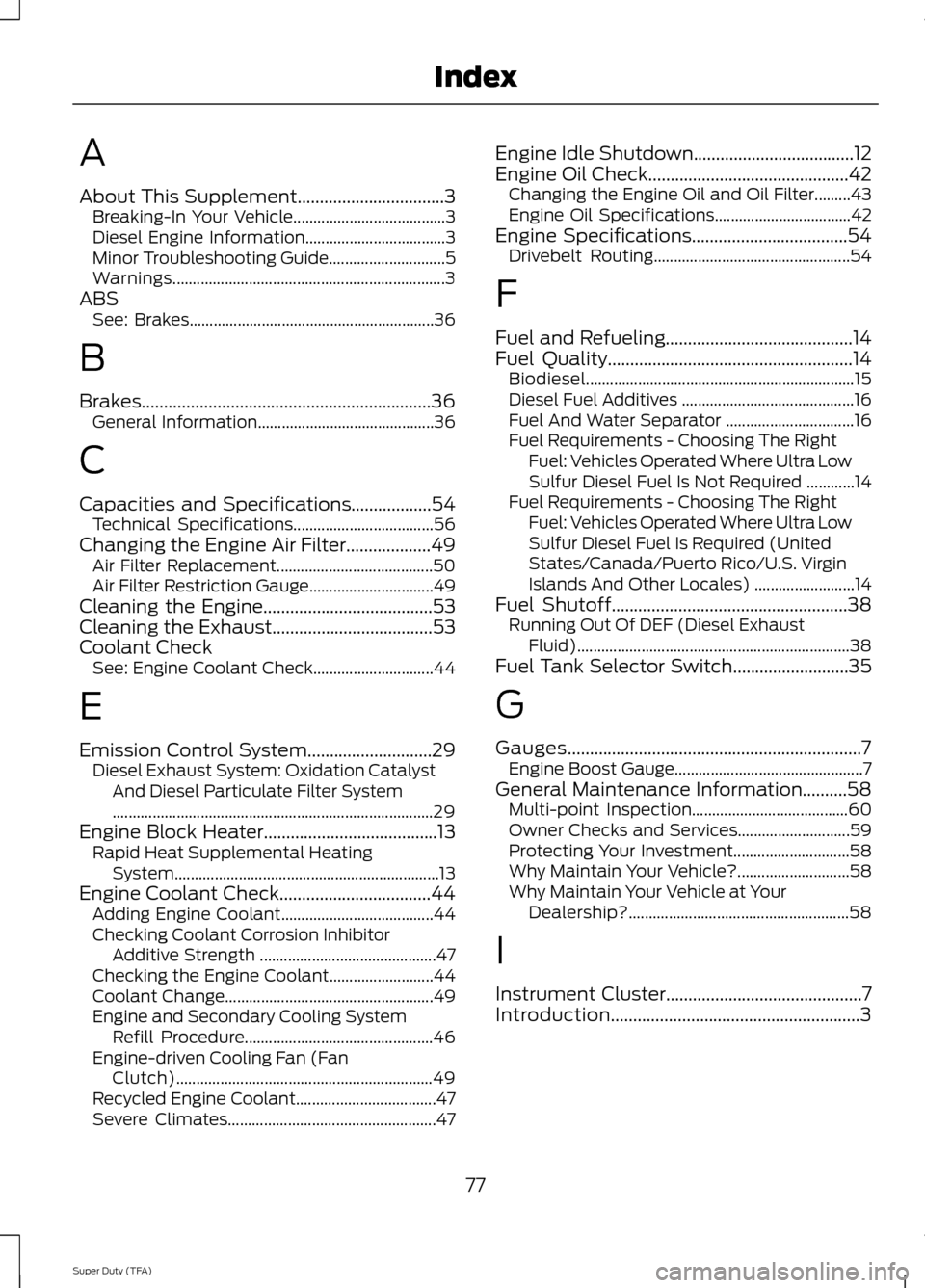
A
About This Supplement.................................3
Breaking-In Your Vehicle...................................... 3
Diesel Engine Information................................... 3
Minor Troubleshooting Guide............................. 5
Warnings.................................................................... 3
ABS See: Brakes............................................................. 36
B
Brakes.................................................................36 General Information............................................ 36
C
Capacities and Specifications..................54 Technical Specifications................................... 56
Changing the Engine Air Filter
...................49
Air Filter Replacement....................................... 50
Air Filter Restriction Gauge............................... 49
Cleaning the Engine......................................53
Cleaning the Exhaust
....................................53
Coolant Check See: Engine Coolant Check.............................. 44
E
Emission Control System............................29 Diesel Exhaust System: Oxidation Catalyst
And Diesel Particulate Filter System
........................................................................\
........ 29
Engine Block Heater.......................................13 Rapid Heat Supplemental Heating
System.................................................................. 13
Engine Coolant Check..................................44 Adding Engine Coolant...................................... 44
Checking Coolant Corrosion Inhibitor Additive Strength ............................................ 47
Checking the Engine Coolant.......................... 44
Coolant Change.................................................... 49
Engine and Secondary Cooling System Refill Procedure............................................... 46
Engine-driven Cooling Fan (Fan Clutch)................................................................ 49
Recycled Engine Coolant................................... 47
Severe Climates.................................................... 47Engine Idle Shutdown....................................12
Engine Oil Check.............................................42
Changing the Engine Oil and Oil Filter.........43
Engine Oil Specifications.................................. 42
Engine Specifications
...................................54
Drivebelt Routing................................................. 54
F
Fuel and Refueling
..........................................14
Fuel Quality.......................................................14
Biodiesel................................................................... 15
Diesel Fuel Additives ........................................... 16
Fuel And Water Separator ................................ 16
Fuel Requirements - Choosing The Right Fuel: Vehicles Operated Where Ultra Low
Sulfur Diesel Fuel Is Not Required ............14
Fuel Requirements - Choosing The Right Fuel: Vehicles Operated Where Ultra Low
Sulfur Diesel Fuel Is Required (United
States/Canada/Puerto Rico/U.S. Virgin
Islands And Other Locales) ......................... 14
Fuel Shutoff
.....................................................38
Running Out Of DEF (Diesel Exhaust
Fluid).................................................................... 38
Fuel Tank Selector Switch..........................35
G
Gauges..................................................................7 Engine Boost Gauge............................................... 7
General Maintenance Information..........58 Multi-point Inspection....................................... 60
Owner Checks and Services............................ 59
Protecting Your Investment............................. 58
Why Maintain Your Vehicle?............................ 58
Why Maintain Your Vehicle at Your Dealership?....................................................... 58
I
Instrument Cluster
............................................7
Introduction........................................................3
77
Super Duty (TFA) Index